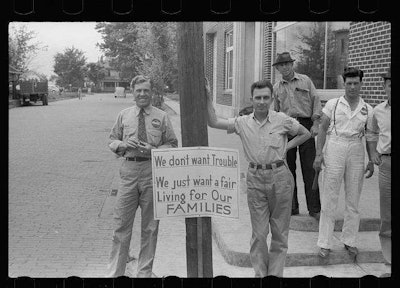
It’s May Day: Do you know where your independent contractors are? If your first reaction is ‘absolutely,’ you might need to have another look how your company classifies workers.
May 1 is the traditional date for celebrating spring in the Northern hemisphere and, for the last 125 years or so, it’s also been International Workers’ Day – a recognition of the organized labor movement. Given this week’s well-publicized drayage driver strike in Southern California, along with ever-increasing business concerns over the Obama administration’s labor-related policies and decisions, now would seem to be a good time to review independent contractor practices. (That’s especially true if you think that a hundred truck drivers at the Los Angeles ports don’t have anything to do with your landscaping service or your local delivery fleet.)
“The independent contractor model has always been front-and-center in California,” California Trucking Association CEO Shawn Yadon told me, following up on my recent visit to the Golden State.
Protecting that model is at the top the association’s list of priorities.
Among the most recent “assaults” on the model by special interests, he’s particularly bothered by “The Big Rig Overhaul,” a report sponsored by the National Employment Law Project, the Change to Win Strategic Organizing Center and the Los Angeles Alliance for a New Economy.
In the report, the pro-labor advocacy groups contend the IC model as it is applied to port drayage drivers is often an illegal form of worker misclassification that results in “dire working conditions.”
LAANE, along with the Teamsters, organized this week’s port protest.
But Yadon’s concern is that the issues brought up in the report will have a broader impact, not just in California. And not just in trucking, I might add.
“There’s quite a bit of misleading information put forth in that report. From CTA’s standpoint, we educate our members about the proper application of the independent contractor model,” Yadon says. “But this report would have you believe that the majority of IC situations are misclassifications.”
CTA points out that independent contractors commonly earn more – not less – than similarly situated employee drivers, and that most owner-ops had worked previously as employees, but chose to become contactors – and preferred to continue working as such.
“They’re clearly independent contractors because they want to be, because of the opportunity and flexibility it provides to them,” he says. “It’s important for us as an industry to protect a model that’s been in place for 75-plus years. It’s the spirit of entrepreneurship for someone to start with that one truck and grow the business if they so chose.”
Yadon’s complete response to the report is here, in an op-ed prepared by CTA.
Indeed, “the assault on the independent contractor model” continues to spread after several recent California court rulings, explains the April 29 InterConnect newsletter from the Benesch lawfirm.
In New Jersey, legislation aimed at drayage and parcel delivery drivers sets a three-part IC classification standard:
- The driver is free from direction or control over the performance of his services, both under contract and in fact
- The driver’s services are outside the usual course of business of the company or outside of the company’s places of business; and
- The driver is customarily engaged in an independent business.
Additionally, Bensesch reports, the Indiana Department of Labor has created a special website to educate the public on worker misclassification and provide a way to report possible company violators.
“While it does not specifically target the transportation sector, worker misclassification is clearly on the radar in Indiana and the Indiana legislature may be gearing up for introduction of new legislation to address the issue,” the newsletter says. “This type of activity should be on our radar screens, as well.”
Some rules may vary between states, and even between agencies with overlapping responsibilities – and enforcement can be very inconsistent – but everyone must pay attention to the IRS when it comes to worker classification. Here are its “common law” rules, or the three categories that provide “evidence of the degree of control and independence” (along with the links to detailed discussion):
- Behavioral: Does the company control or have the right to control what the worker does and how the worker does his or her job?
- Financial: Are the business aspects of the worker’s job controlled by the payer? (these include things like how worker is paid, whether expenses are reimbursed, who provides tools/supplies, etc.)
- Type of Relationship: Are there written contracts or employee type benefits (i.e. pension plan, insurance, vacation pay, etc.)? Will the relationship continue and is the work performed a key aspect of the business?
Of course, INAL, as they say on the Web, or “I’m not a lawyer.” But I do know enough to suggest that any business owner or manager with doubts should consult one, or your CPA – and certainly your industry’s trade association.
These days, one phone call to the right bureaucrat can make sloppy paperwork very expensive. And those who knowingly flaunt worker classification rues are playing Russian roulette with their own businesses – and putting the model in jeopardy for those who are using independent contractors appropriately.








